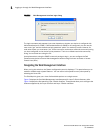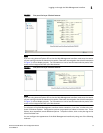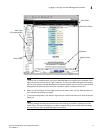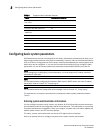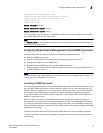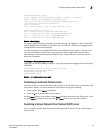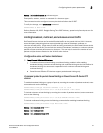
20 PowerConnect B-Series FCX Configuration Guide
53-1002266-01
Configuring basic system parameters
2
To specify an SNMP trap receiver and change the UDP port that will be used to receive traps, enter
a command such as the following.
PowerConnect(config)# snmp-server host 2.2.2.2 0 mypublic port 200
PowerConnect(config)# write memory
Syntax: snmp-server host <ip-addr> [0 | 1] <string> [port <value>]
The <ip-addr> parameter specifies the IP address of the trap receiver.
The 0 | 1 parameter specifies whether you want the software to encrypt the string (1) or show the
string in the clear (0). The default is 0.
The <string> parameter specifies an SNMP community string configured on the Dell PowerConnect
device. The string can be a read-only string or a read-write string. The string is not used to
authenticate access to the trap host but is instead a useful method for filtering traps on the host.
For example, if you configure each of your Dell PowerConnect devices that use the trap host to send
a different community string, you can easily distinguish among the traps from different Dell
PowerConnect devices based on the community strings.
The command in the example above adds trap receiver 2.2.2.2 and configures the software to
encrypt display of the community string. When you save the new community string to the
startup-config file (using the write memory command), the software adds the following command
to the file.
snmp-server host 2.2.2.2 1 <encrypted-string>
To add a trap receiver and configure the software to encrypt display of the community string in the
CLI and Web Management Interface, enter commands such as the following.
PowerConnect(config)# snmp-server host 2.2.2.2 0 PowerConnect-12
PowerConnect(config)# write memory
The port <value> parameter allows you to specify which UDP port will be used by the trap receiver.
This parameter allows you to configure several trap receivers in a system. With this parameter,
Brocade Network Advisor Network Manager and another network management application can
coexist in the same system. Dell PowerConnect devices can be configured to send copies of traps
to more than one network management application.
Specifying a single trap source
You can specify a single trap source to ensure that all SNMP traps sent by the Layer 3 switch use
the same source IP address. For configuration details, refer to “Configuring ARP parameters” on
page 810
Setting the SNMP trap holddown time
When a Dell PowerConnect device starts up, the software waits for Layer 2 convergence (STP) and
Layer 3 convergence (OSPF) before beginning to send SNMP traps to external SNMP servers. Until
convergence occurs, the device might not be able to reach the servers, in which case the messages
are lost.
By default, a Dell PowerConnect device uses a one-minute holddown time to wait for the
convergence to occur before starting to send SNMP traps. After the holddown time expires, the
device sends the traps, including traps such as “cold start” or “warm start” that occur before the
holddown time expires.
You can change the holddown time to a value from one second to ten minutes.



